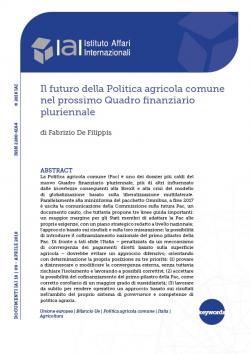Il futuro della Politica agricola comune nel prossimo Quadro finanziario pluriennale
The Common Agricultural Policy (CAP) is one of the hottest dossiers of the new Multiannual Financial Framework, as it is influenced more than others by the uncertainty of Brexit and the crisis of the model of globalization based on multilateral liberalization. In parallel to the mini-reform of the Omnibus package, a Commission communication on the future CAP was released at the end of 2017. Although cautious, it proposes three important guidelines: a greater margin for member states to adapt the CAP to their needs, with a strategic plan drafted at national level; an approach based on results and their measurement; the possibility of introducing the national co-financing of the first pillar of the CAP. Faced with these challenges, Italy, which is penalized by a mechanism of convergence of direct payments based on agricultural area, should avoid a defensive approach, strongly orienting its position toward three priorities: (1) trying to defuse or change the external convergence, however without risking isolation and working on possible improvements; (2) accepting the possibility of co-financing the first pillar of the CAP as a corollary to a greater degree of subsidiarity; and (3) working immediately to implement a results-based approach within the framework of its own governance system and agricultural policy competences.
Paper prepared in the framework of the project “Quadro finanziario pluriennale dell’Ue 2021-2027. Risorse, strumenti e possibili sviluppi”, March 2018. Presented at the conference "Quali priorità per l’Europa del futuro. Il Quadro finanziario pluriennale dell’Unione europea”, Rome, 17 April 2018.
-
Details
Roma, IAI, April 2018, 11 p. -
In:
-
Issue
18|09
Introduzione
1. La Pac post-2020: le questioni aperte e gli interessi italiani
2. Gli scenari geopolitici e la Pac
3. La comunicazione della Commissione sulla Pac e il Regolamento Omnibus
Conclusioni: Orientamenti per una posizione italiana sulla Pac
Riferimenti



